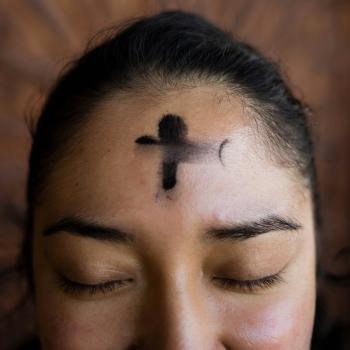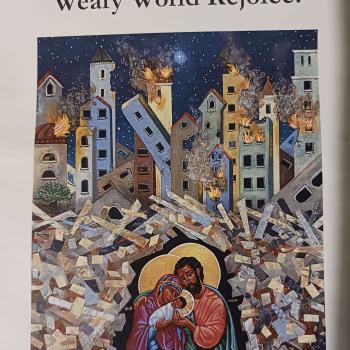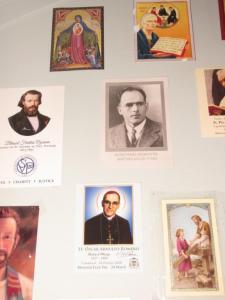In Ryan Klassen’s recent guest post, he noted that the Mennonite communion is only beginning to take a more active role in society now that it is no longer subject to persecution like it was in the past and that the Catholic Church is likewise only beginning to come to terms with the end of Christendom. I think he is right about that and correct to think we could learn much from each other.
To the end of better coming to terms with the happy fall of Christendom, it may be fruitful to briefly consider the shift from the Davidic monarchy to life in exile which the people of God had to endure as an analogy to the Church’s current shifting situation vis-a-vis the “world.” It seems appropriate to start with Mennonite theologian John Howard Yoder’s Jeremianic ecclesiology.
Yoder may be the most well-known proponent of an exilic ecclesiology, or what he called a Jeremianic (rather than Constantinian) ecclesiology. Yoder’s reading of Jeremiah and the Jewish communal life in the exile is centered on Jeremiah 29:7 “seek the welfare of the city where I have sent you, and pray to JHWH on its behalf, for in its welfare you will find your welfare.” Based upon this verse, Yoder believes that the exile away from Jerusalem was not meant to be a mere “hiatus”, but rather after Jeremiah, “dispersion shall be the calling of the Jewish faith community.”[1]
According to Yoder’s reading of Jeremiah, the Jewish communal life in the exile took on a few key characteristics, characteristics which he believes the post-Christendom Church should emulate. 1) The exilic community relied on the sacred text of the Torah as the cornerstone of communal identity definition. 2) Singing and reading these texts came to be the primary form of worship, rather than temple sacrifices. 3) Local cells of the Jewish community, called synagogues, were formed wherever ten households were present. No hierarchical recognition or initiative was needed or desired. 4) “International unity was sustained by intervisitation, intermarriage, commerce, and rabbinic consultation.”[2] 5) The community relied not on any Jewish philosophy or “doctrine”, but on “the common life itself, the walk, halakah, the shared remembering of the story behind it”[3] for maintenance of identity.
Yoder believes that the earliest Christian communities modeled themselves after the Jewish exilic communities, embracing the “paradox of the power of weakness”.[4] Additionally, Yoder sees both the exilic Jews and the early Christians as witnessing to the transcendence and primacy of God by refusing to “grant [the worldly powers’] idolatrous claim to be in charge of history,”[5] a claim which places the empire in direct competition with the Judeo-Christian notion of providence.
However, despite the notoriety of Yoder’s claims, the accuracy of his reading of the text and the applicability of his reading to post-Christendom ecclesiology, especially Catholic ecclesiology, can be questioned. For example, Peter Ochs and Michael Cartwright, the editors of The Jewish-Christian Schism Revisited, a collection of Yoder’s essays, are both critical of Yoder on this point. For Ochs, “Yoder has made a beautiful monument of one chapter of Jeremiah’s ministry. But there are many chapters,”[7] while Cartwright observes that “Yoder’s typology is not only over-determined but also fails to take into account the significant linkages that existed between the prophetic orientation of Jeremiah and the priestly vocation of Israel.”[8] Thus, Daniel Smith-Christopher’s view of the exile as a diagnosis rather than a paradigm for the post-Christendom churches may prove to be more fruitful than Yoder’s[9].
In addition to Jeremiah, Smith-Christopher focuses on a few other important exilic figures. Ezra and Nehemiah exhibit the importance of maintaining communal identity. This is an especially relevant problem for Catholics (in America) today who are often more committed to their political allegiances and to their football teams than they are to living a life in imitation of Christ. After all, “If Caesar can get Christians to swallow the final solution and drop the atomic bomb, there is no limit to what we will not do for the modern world”[10]. Smith-Christopher reads the Ezra-Nehemian emphasis on purity as an example of nonconformity.[11] Ezra’s somewhat offensive rejection of mixed marriages is not to be seen as xenophobic, but as a result of a minority consciousness and in reference to the best interests of community solidarity.[12] In other words, what is to be kept pure is the community itself. When the surrounding culture is hostile to faith in God, the people of God must first protect their own identity in order to be missiological; this is not sectarian.
Thus, for Smith-Christopher, “Ezra fails where the Bible does not,”[13] because in its canonical context, Ezra’s ad intra emphasis on purity is complemented by the missiological emphases of Isaiah, Jonah, and Jeremiah. The people of God are indeed to seek the peace of the foreign city and to bear witness to God’s primacy. This involves recognizing with Daniel that God’s concern is for his people and that the empire or nation-state is of little significance.[14] Daniel exhibits no attempt to re-grasp the lost power of the Davidic monarchy, and the Church need not attempt to lobby for political influence but ought to model an alternative communal life: witness, not advocacy.[15] Indeed, for Smith-Christopher, Jonah shows us that to be in exile is to be a people of mission, to live in the world, but not of the world. To serve the city of man by pointing to the city of God. For Smith-Christopher, the Church’s “task is Jonah’s mission to the world, informed by Ezra’s eye to nonconformity and embodying Tobit’s compassion and wise practicality”.[16]
The question remains, however, how can a Church whose credibility has been destroyed through its own most grievous faults possibly hope to bear witness to the city of God? How can its being a “people set apart” be seen as anything but hypocrisy? If Pope Benedict’s claim is true, that “History shows that, when the Church becomes less worldly, her missionary witness shines more brightly… [and she] can reach out more effectively and in a truly Christian way to the whole world,” then how might this becoming less worldly witness to anything more than a sort of triumphalism in which you are either with us or against us, on the ark or drowning? Here, the key is found not in Jonah’s expression of the mission of the Jews to the world, but in that of Isaiah’s suffering servant. After all, nearly the entire history of Israel as the chosen people of God is told in a penitential key, a key which, according to William Cavanaugh, is vital for the proper life of the church. “The recognition of our sinfulness becomes not recognition of our tragic fate but a humble acknowledgment that we are not in charge of making history come out right by violent means…The city of God is not the shape of our triumph, but of our repentance.”[17]
Within the life of the Church, this is most frequently and powerfully expressed in the liturgy, as it was for those suffering under Seleucid terror. For example, in Daniel’s prayer of penitence, he confesses sins to God and begs for mercy and deliverance (Daniel 9:4-19). Smith-Christopher shows that such acknowledgment of shame in penitential prayers, like the one in Daniel, serves as a “break with the past, to be an alternative people of God…To remind oneself constantly of the failure of power (in the ancestors and kings), to advocate an alternative mode of living.”[19] Accordingly, by placing the blame for the exile and persecution at their own feet, that is, as a result of their sin, the Jews who prayed Daniel’s prayer stripped Antiochus’ claim to be in control and re-situated him as an implement of punishment used by God, who remains in control.
Similarly, in order to be an effective witness as a people set apart, the Church must acknowledge her own past sins and be a reminder to the world of humanity’s utter dependence on God’s mercy. “What the church makes visible to the world is the whole dynamic drama of sin and salvation, no only the end result of humanity purified and unified.”[20] Of course, this repentance mustn’t be a utilitarian strategy but a cry to God, a cry motivated by the experience of sin and a simultaneous witness to the world that even now God has not abandoned his people. “It is in this repentance that the church may make Christ and the drama of sin and redemption possible,”[21] and fulfill its role as the universal sacrament of salvation.
By embracing her status as an “exilic” community, the Church can recommit herself to covenant fidelity and bear penitential witness to the saving work of God in the world. Indeed only by becoming less worldly and more like her crucified Lord can the Church fulfill her mediatory mission to the world. And, as Archbishop Diarmuid Martin of Dublin recently explained, this must happen most fundamentally at the local level.
[W]e must admit that unfortunately the Church in Ireland was slow and is slow in recognising the fragility of the infrastructure of faith and in many ways continues to think that the challenges of tomorrow can be addressed with the pastoral methods of yesterday. For their part many well-intentioned outsiders fail to understand the particular characteristics – both historical and contemporary – of the Irish Church and they fail to understand the depths of the current crisis.
The challenge of faith in Ireland can only be addressed by radical efforts of new evangelization. That new evangelization must however have its own Irish characteristics
The same is true in America and throughout the world.
[1] Yoder, John Howard, Michael G. Cartwright, and Peter Ochs. “See How They Go with Their Face to the Sun” In The Jewish-Christian schism revisited. Grand Rapids, MI: Eerdmans, 2003, p. 183
[2] Yoder, “See how they go…”, 187.
[3] Yoder, “See how they go…”, 187,
[4] Yoder, “On not being in charge” In The Jewish-Christian schism revisited. Grand Rapids, MI: Eerdmans, 2003, 171.
[5] Yoder, On not being in charge, 171.
[7] Ochs, “Commentary on ‘See How They Go with Their Face to the Sun’” in The Jewish-Christian Schism Revisited, 204.
[8] Cartwright, “Afterword: ‘If Abraham is Our Father . . .’ The Problem of Christian Supersessionism after Yoder,” The Jewish-Christian Schism Revisited, 219.
[9] Smith-Christopher, Daniel. Theology of Exile, 191.
[10] Hauerwas, Stanley. Resident Aliens, 193.
[11] Smith-Christopher, 138-163.
[12] Smith-Christopher, 146.
[13] Smith-Christopher, 200.
[14] Smith-Christopher 187-88.
[15] Smith-Christopher, 198.
[16] Smith-Christopher, 202.











